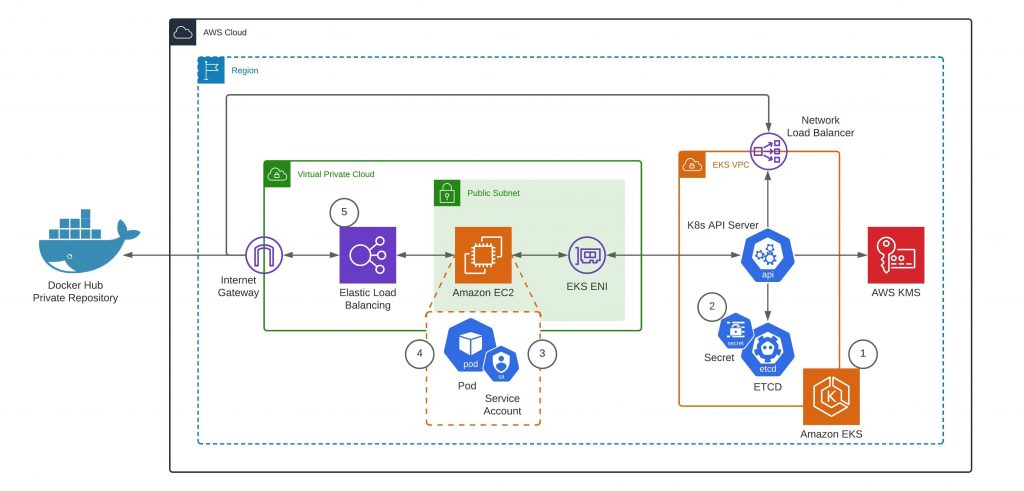Containers
Category: Technical How-to
Modernize Java and .NET applications remotely using AWS App2Container
Since the launch of AWS App2Container, customers have been asking for the ability to remotely manage the migrations of Java and .NET applications running on Windows or Linux hosts. Beginning with the version 1.2 of App2Container, users can accomplish containerization of their workloads without installing A2C software on the application servers. The remote execution feature […]
Setting up end-to-end TLS encryption on Amazon EKS with the new AWS Load Balancer Controller
In this blog post, I’ll show you how to set up end-to-end encryption on Amazon Elastic Kubernetes Service(Amazon EKS). End-to-end encryption in this case refers to traffic that originates from your client and terminates at an NGINX server running inside a sample app. I work with regulated customers who need to satisfy regulatory requirements like […]
Advertising click-prediction modeling on Amazon EKS
In digital advertising, the ad click-through rate (CTR) model predicts the probability of a click given the ads and context x (for example, shopping query, time of the day, device). The output of a CTR model can be seen as a conditional probability p(y = click|x). A precise estimation of this probability influences our ability […]
Turbocharging EKS networking with Bottlerocket, Calico, and eBPF
This post is co-authored by Alex Pollitt, Co-founder and CTO at Tigera, Inc. Recently Amazon announced support for Bottlerocket on Amazon Elastic Kubernetes Service (Amazon EKS). Bottlerocket is an open source Linux distribution built by Amazon to run containers focused on security, operations, and manageability at scale. You can learn more about Bottlerocket in this […]
Authenticating with Docker Hub for AWS Container Services
Docker Hub has recently updated its terms of service to introduce rate limits for container image pulls. While these limits don’t apply to accounts under a Pro or Team plan, anonymous users are limited to 100 pulls per 6 hours per IP address, and authenticated free accounts are limited to 200 pulls per 6 hours. […]
Using EBS Snapshots for persistent storage with your EKS cluster
Originally, containers were a great fit for stateless applications. However, for many use cases there is a need for persistent storage, without which stateful workloads are not possible. Kubernetes first introduced support for stateful workloads with in-tree volume plugins, meaning that the plugin code was part of the core Kubernetes code and shipped with the […]
Ship and visualize your Istio virtual service traces with AWS X-Ray
AWS X-Ray is a managed distributed tracing system that helps customers gain end-to-end visibility of requests and provides rich visualization of connected services. This post will show how customers can integrate AWS X-Ray as a backend for Zipkin traces generated from services in a Istio service mesh.
Accelerate modernization of your application using App2Container
Introduction Many enterprises want to modernize their existing applications and containerize them to minimize disruptions that could stem from clunky, outdated and unscalable legacy systems. These enterprises need tools to simplify the containerization process of existing Java and .NET applications and increase operational efficiency, harmonize CI/CD processes, and increase agility. AWS App2Container (A2C) enables companies […]
Create a pipeline with canary deployments for Amazon EKS with AWS App Mesh
In this post, we will demonstrate how customers can leverage different AWS services in conjunction with AWS App Mesh to implement a canary deployment strategy for applications running on Amazon Elastic Kubernetes Service (Amazon EKS). As stated in the post “Getting started with App Mesh and EKS”, many customers are currently implementing microservices in a […]
De-mystifying cluster networking for Amazon EKS worker nodes
Running Kubernetes on AWS requires an understanding of both AWS networking configuration and Kubernetes networking requirements. When you use the default Amazon Elastic Kubernetes Service (Amazon EKS) AWS CloudFormation templates to deploy your Amazon Virtual Private Cloud (Amazon VPC) and Amazon EC2 worker nodes, everything typically just works. But small issues in your configuration can result […]








